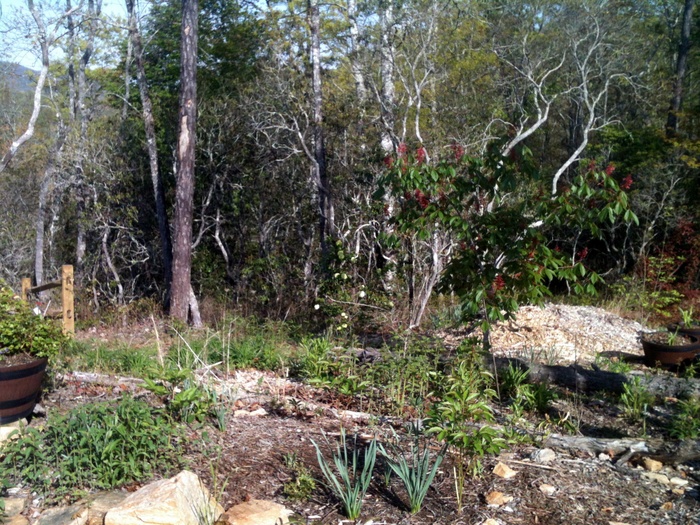

|
|
|


The story of our land is much older than we are; it is much older than the first European settlement in America. It begins when the Appalachians were the tallest mountains on earth, a time that life as we know it today did not exist. Paleolithic Americans hunted the woods around us; according to the Cherokees, Pilot Mountain, where our farm rests, was the site of one of the creation stories; early citizens of the United States of America gradually migrated up the Davidson River and French Broad River valleys to settle and to build homes and lives for their families. Our part of the story began only 20 years ago when we first purchased the land. Even at the beginning we had such a sense of being merely custodians of this property during our lifetime. Out of that deep sense of responsibility, we deliberately worked, played and began to write our own part of this land’s story. A crystal clear, singing freshwater trout stream runs through our property. Yet 20 years ago, by the time the stream left the national forest and arrived at the French Broad river over 2 miles later, there was no area of shade that could offer trout fingerlings temperatures essential for their survival. Because of agricultural efforts on the banks of the creek, the sediment and fertilizer washing down to the French Broad were rapidly changing the health of the creek. Although we could not change much of what we saw, we saw that we could change what was on the land we call our own. Today leaving 20+ feet of broad swaths of wildflowers and native grasses on the creek banks creates a natural buffer from water contamination from the nearby road and any chemicals remaining in the land; the shade from the young saplings and tall wildflowers also creates a place where the trout fingerlings can rest and feed before joining the current in its rush to the river. The land around the creek presented its own set of problems. It had spent the last 60-70 years growing corn. In the time between the last corn crop and our part of the story, the land we call the “near” and “far” meadows had become infested with invasive plants that prevented the return of the plants and animals that should live there. Multiflora rose, bittersweet, and honeysuckle had taken up far more of their share of the space so those animal and plant communities that should be present were disrupted or nonexistent. For the last 20 years we have worked with these two meadows to accomplish two goals: return the majority of the meadows to wildflowers and provide a home for those original residents, and to manage small portions for agriculture in a way that does not harm the ecosystem but also provides for the human inhabitants of the land. We have almost 40 blueberry bushes, 10+ elderberry bushes as well as a few grapes that we have planted there. The native blackberries have returned to the land, and we control the patch size for meadow diversity—and still enjoy as much as a gallon a day of blackberry harvest. The wildflowers of the meadows encourage pollinators to visit, and this enhances our crop production. Although we do have deer, rabbit, raccoons, possums, and fruit loving birds, the traditional “pests” of the gardener, the natural environment provides plenty of food for them. We intentionally plant enough for all of us who reside on the farm. On the ridgetop where our cabin sits, we created another meadow. We located the cabin on the ridge as we wanted to minimize the impact of our lives on the creek. After the septic tank was put in, the land was devastated, and we began to implement our five year plan for creating the meadow that would replace the laurel that originally grew there. We worked the soil, seeded, transplanted, removed and just kept going to provide a place for the animals and plants of our land. As we did in the meadow, we have integrated our wildflower meadow with agricultural projects. We grow vegetables in raised beds near the house so that we can harvest the rainwater from our roof. We grow raspberries, more blueberries and grapes a little down the slope to take advantage of the rain that flows downhill. The wood cut from clearing the home site has become our railings, furniture and fences. The leaves that fall each year have become the compost that feeds the gardens. Rabbits, squirrels, deer, raccoons, songbirds, red-tailed hawks, box turtles and three kinds of hawks frequent the land and skies. We have come to appreciate the skunk that patrols the high meadow because of his/her diligence in tearing out of the yellow jacket nests. We do, however, insure that we and our dogs honor the skunk’s need for solitude. Four generations of our family and beloved friends have shared the mountain with us and become a part of this land’s story. For now we continue to be the custodians of this beautiful land and struggle to do our part to honor its marvelous place in God’s creation. Each day it teaches us more about how we humans fit into this grand place called earth and how the choices we make ripples through time and generations to come. We strive to live fully in the Light as we seek the truth of our part in this land’s story. Each day in so many ways, we are reminded that The earth is the Lord's, and everything in it (1 Corinthians 10:26). ❧ Hope Ascher, Brevard Friends Meeting |